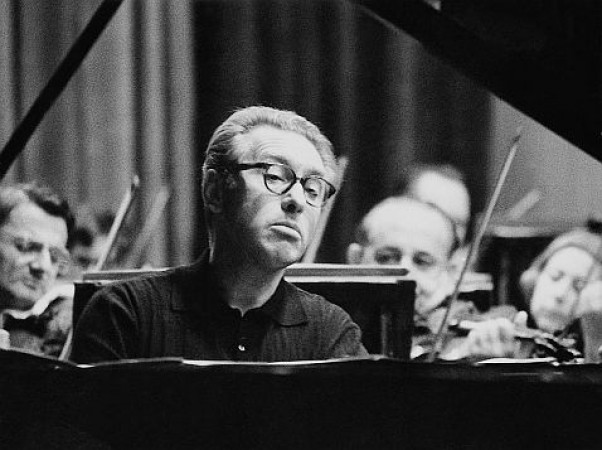
19 November 1921, Budapest – 14 June 1976, Zürich
Géza Anda made his debut in Budapest as the soloist of Brahms' Piano Concerto in B-flat major in 1939; the Philharmonic Orchestra was conducted by Willem Mengelberg. Finishing his studies at the Academy of Music he traveled to Berlin to perform César Franck's Symphonic Variations. Wilhelm Furtwängler, conductor of the concert named the twenty years old pianist the troubadour of the piano. A powerful upbeat for the beginning of a brilliantly promising career, but the arc of this career was interrupted for some years.
Anda began his systematic piano studies in 1933. At the beginning he studied with Imre Stefániai, Emánuel Hegyi and Imre Keéri-Szántó. Regarding his artistic maturity the last two years (1939-1941) with Ernő Dohnányi was definitive. While ‘I attended the chamber music lessons of Leó Weiner, as well' – as he recounted in an interview – ‘and I can only say the same that all the others from my generation being a violinist, violist, cellist or pianist, that I studied the most from him... the instrument itself did not have an importance for him. We did not study to play our instruments with Weiner but to understand music...' According to the recollections, at the legendary master classes of Géza Anda the weinerian spirit lived on.
He moved to Switzerland in 1943. The period up to 1948 was spent with the struggle for survival. He was a regular performer of the Salzburg Festival from 1951 on. Géza Anda's name became the synonym of virtuosity across Europe at that time. He played the piano concertos of Beethoven, Liszt, Schumann, Grieg, Brahms, Tchaikovsky and Rachmaninoff. At that time he had not worked on the Mozart concertos intensively, yet. He played several times with Clara Haskil between 1953 and 1958. A joint performance of Mozart's Two Piano Concerto in E-flat major (K 365) proved to be decisive regarding the change of Anda's artistic orientation. He recorded all the piano concertos (Deutsche Grammophon), as a result of an intensive studying of Mozart's music, conducting his orchestra at the piano, following Edwin Fischer's example. He composed the missing cadenzas in all cases. (The cadenzas were published in 1973.) Musicians and the audience regarded him not ‘only' as a genial virtuoso already, but a Mozart-specialist, as well. He gave master classes at the International Summer Academy of the Salzburg Mozarteum since 1953. He received the Swiss citizenship in 1955.
He played the three Bartók piano concertos in the same program in 1957 under the baton of Ernest Bour. He played the First Piano Concerto at this concert for the first time. His recording of the Second and Third Piano Concertos with Fricsay conducting was awarded a prize (Grand Prix du Disque). In 1967 ‘after some twenty-five years of being away he returned home triumphantly'. Hungarian critics wrote superlatives on his playing. His interpretation of Bartók's Second Piano Concerto and Schumann's Davidsbündlertänze ‘arrived at the heights of' the playing of Sviatoslav Richter and Gieseking. He gave further recitals in Budapest later, fulfilling a wish greeting his return: ‘...our only wish is that the character of Géza Anda should not disappear in a euphemistic distance again, rather he should be our guest more often again from now on!'
He made his last recording with Chopin Waltzes in December, 1975 and gave his last recital in Innsbruck on June 1, 1976. He worked with such conductors as Herbert von Karajan, Karl Böhm, Wolfgang Sawalisch, Ernest Ansermet, György Széll, or György Solti through his career. Following his recital in Budapest in 1976 György Kroó wrote: ‘The magic of Anda's piano playing lies primarily in his extraordinary culture of touch. There are just a very few piano sounds in the world just as beautiful. [...] When he plays passages, and even longer, tied scale-like melodies across the whole keyboard, the tone color changes like alternating human voices: the alto becomes tenor, the tenor darkens to bass. And then there are those special, hardly pressed, almost just palpated middle voices running and gliding through in the Schumann work, that conjures almost a hoffmannian atmosphere around Anda's performance. Is it still the technique, a question of touch only? By no means. We have been talking about the music for a long time [...]"
M. Sz.


